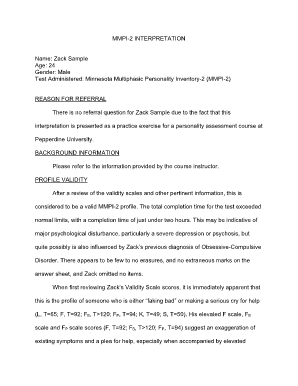
After decades of use, the need for restandardization became clear. McKinley developed the original MMPI by selecting items for inclusion that discriminated a criterion group (i.e., those with a given clinical diagnosis) and comparison groups (i.e., nonpatient normative groups and those with other diagnoses). Through a multistep process, Starke Hathaway and J.


Nevertheless, they provide potentially useful information about problem areas, personality types and correlates, and treatment implications. As Roger Greene emphasizes, these descriptions are probabilistic statements based on modal patterns and, as such, do not necessarily describe individuals obtaining a specific code.
Mmpi 2 content scales code#
In addition to interpretive material linked with individual scale and subscale scores, considerable research has identified and supported descriptions associated with particular patterns of elevations, known as code types, reflecting the 1 to 3 most elevated clinical scales and their combinations. Scales with a T-score of 65 or greater are considered clinically significant. Raw scores on these scales are transformed to norm-based T-scores (mean = 50, standard deviation = 10) to enhance the interpretability of results. The test includes multiple validity indices, assessing test-taking attitudes and approach 10 basic, numbered clinical scales (1 = Hypochondriasis, 2 = Depression, 3 = Hysteria, 4 = Psychopathic Deviate, 5 = Masculinity-Femininity, 6 = Paranoia, 7 = Psychasthenia, 8 = Schizophrenia, 9 = Hypomania, 0 = Social Introversion, with all but scales 5 and 0 considered core clinical scales) and their subscales as well as more than five dozen content scales (e.g., Antisocial Practices, Anxiety), content component scales (e.g., Negative Treatment Indicators: Low Motivation), personality psychopathology trait scales (e.g., Aggressiveness, Negative Emotionality/Neuroticism), and supplementary scales (e.g., Addiction Potential, Overcontrolled-Hostility). First published in 1942 and revised in 1989, the instrument yields a wealth of clinical data and is used across multiple clinical and medical settings, for employment screening and selection, and in a variety of forensic situations. Using 567 true-false items, the MMPI-2 assesses a diverse range of personality characteristics symptoms of psychopathology and patterns of behavior, attitudes, and concerns. to create a set of scales that accurately measure the core psychological constructs of the Clinical scales whilst enhancing convergent and discriminant validity.The original Minnesota Multiphasic Personality Inventory (MMPI) and its successor have been recognized as the most widely used and researched objective clinical personality inventories. The results also support the aims of Tellegen et al. The findings provide strong support for the construct validity of the MMPI-2/MMPI-2-RF RC scales and the assessment of personality disorders in a forensic setting. The RC scales also accounted for additional variance over the NEO-PI-R domain scales for 8 out of the 10 SCID-II PQ personality disorder raw scores and provided a clinically accurate profile of personality disorders when expressed in their more pathological variants in a forensic population. The findings for this study demonstrated the construct validity of the RC scales whenĬompared to the SCID-II PQ personality disorder raw scores and the NEO-PI-R domainĪnd facet scales. This study utilised a forensic sample (n = 83) in order to analyse the construct validity of the RC scales when compared to the Structured Clinical Interview for the fourth edition of the DSM (DSM-IV APA, 1994) Axis II Disorders-Personality Questionnaire (SCID-II PQ First, Gibbon, Spitzer, Williams & Benjamin, 1997) and the Revised NEO Personality Inventory (NEO-PI-R Costa & McCrae, 1992). Tellegen et al.'s project resulted in the development of nine RC scales that were designed to be independent of the pervasive influence of the first factor, more distinctive and a more accurate measure of the core psychological constructs the original Clinical scales were designed to measure. Limitations of the Clinical scales and to measure the core psychological constructs of each of the Clinical scales whilst enhancing convergent and particularly discriminant validity. (2003) constructed the RC scales to address the perceived psychometric (MMPI-2 Butcher, Dahlstrom, Graham, Tellegen, & Kaemmer, 1989) and MMPI-2-Restructured Form (MMPI-2-RF Ben-Porath & Tellegen, 2008) and the assessment of

Scales (Tellegen et al., 2003) of the Minnesota Multiphasic Personality Inventory-2

The current study examined the construct validity of the Restructured Clinical (RC)


 0 kommentar(er)
0 kommentar(er)
